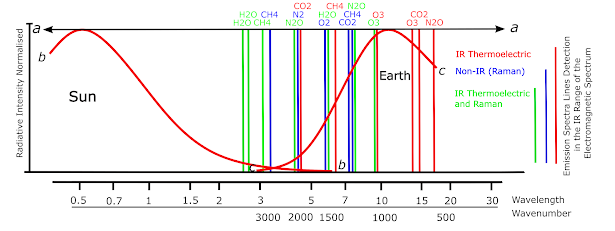The Dunn Raman Spectroscopy Climate Debate Fallacy
The Dunn Fallacy
A persistent fallacy has developed from a group of thinkers as part of a rebuttal to my work, primarily from physicist Michael Dunn, whom I have communicated with extensively on this issue and to whom I give name credit on his claim. This is a strawman fallacy.
Dunn and others respond to my work (words to the effect): "Blair, there is no Raman effect in the atmosphere that contributes to the greenhouse effect". This is something I have never claimed and never thought of claiming because it is just not true. No one has ever suggested this. Dunn and others have brought this claim into existence in a red herring fallacy or a special pleading fallacy. Dunn and others are maintaining, saving the status quo, that only the IR-active spectra emit and absorb IR heat radiation and the Raman active modes do not.
I am proposing radiating pure N2 with infrared heat and measuring the temperature change (or not) with the Raman CARS spectrometer. I have spoken with expert scientists, and they agree it is possible.
I am claiming that the Raman spectrometer exploits the Raman effect by shining laser light to infer the quantum predicted modes and from this, the temperature is measured. That the Raman modes of CO2, H2O N2 and O2, for instance, are excited by infrared heat and this is measured only by the Raman spectrometer — independent of the Raman effect.
I am proposing radiating pure N2 with infrared heat and measuring the temperature change (or not) with the Raman CARS spectrometer. I have spoken with expert scientists, and they agree it is possible.
My Claim
Raman Spectra in the Infrared
The discovery of the non-greenhouse gases emission spectral lines of N2, O2, CO2, N2O and CH4 (1929).
These lines were discovered long after Tyndall first discovered greenhouse gases (1859). They come after the advent of the bolometer blackbody radiation curve that defines the greenhouse gas spectral modes of greenhouse gases. These lines were discovered in the quantum age and are known to have furthered the quantum revolution as proof. They are explained by Bohr's (and others) quantum atomic model.
These modes are ignored in greenhouse theory.
Raman Spectra of Polyatomic Gases R. G. Dickinson, R. T. Dillon, and F. Rasetti Phys. Rev. 34, 582 – Published 15 August 1929 https://authors.library.caltech.edu/5959/1/DICpr29.pdf
https://journals.aps.org/pr/abstract/10.1103/PhysRev.34.582
FEBRUARY 8, 1930 NATURE The Raman Effect. By Dr. A. C. MENZIES.
https://www.nature.com/articles/125205a0.pdf
Figure: Raman spectral lines and IR spectral lines of the main gases of Earth's atmosphere. These spectral lines are by greenhouse theory, modulated by the blackbody radiation curve. My theory is that they are, by Raman instrument measurements, the dominant spectral lines.
My work:
The following is my interpretation of the infrared atmosphere
Quantum Mechanics and Raman Spectroscopy Refute Greenhouse Theory and
The Greenhouse Gases and Infrared Radiation Misconceived by Thermoelectric Transducers
Settling The Climate Woo With Quantum Based Raman Spectroscopy





Comments
Post a Comment